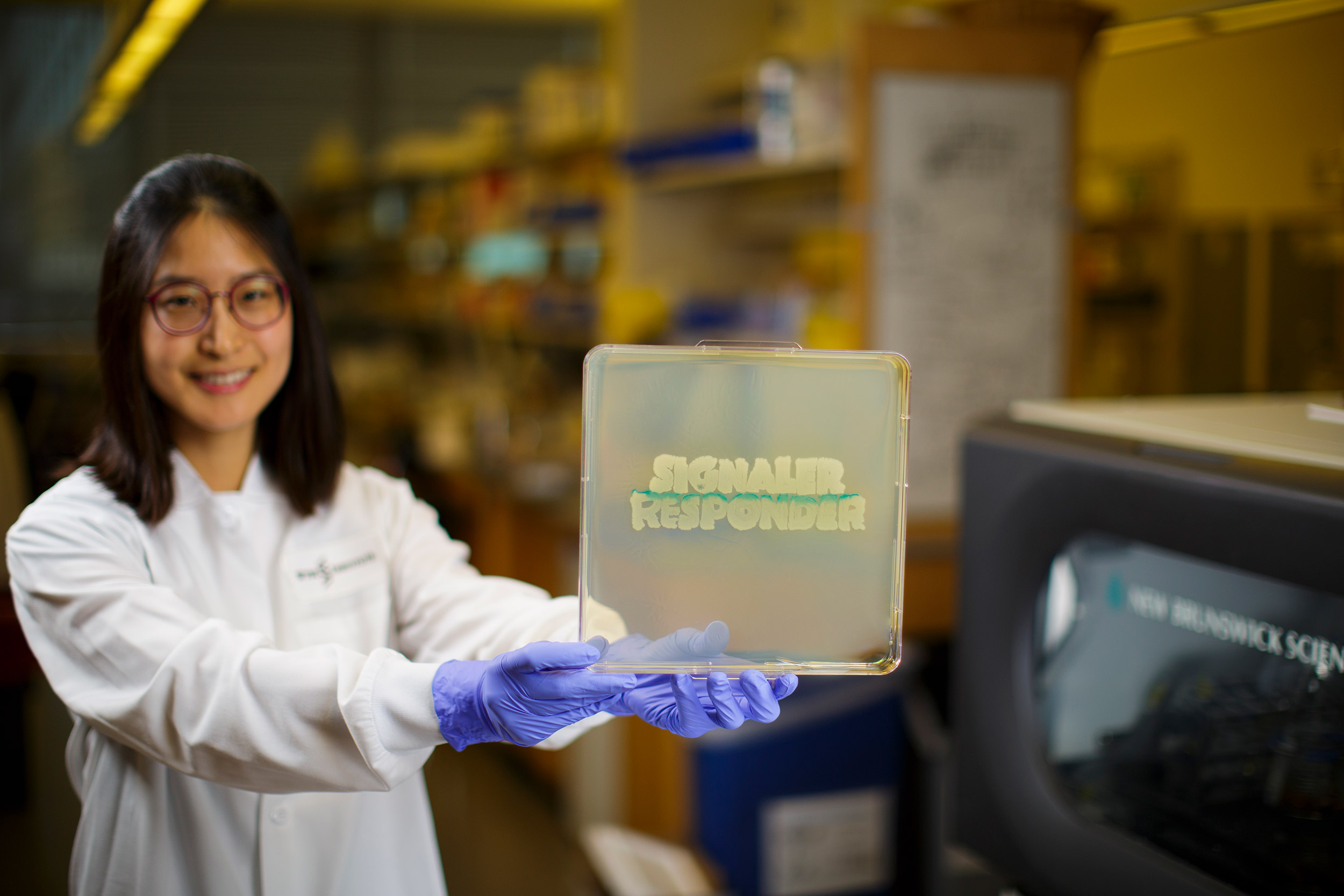
First author Suhyun Kim holds a plate containing the signaler bacteria S. Typhimurium and the responder E. coli, the latter of which is turning greenish-blue in response to a signal from the former.
Credit: Wyss Institute at Harvard University
A telephone for your microbiome
Genetic engineering allows different species of bacteria to communicate
With more than 1,000 species of bacteria identified in the human gut, understanding this incredibly diverse biological ecosystem can impact health and disease. As they do, scientists may be setting the stage for creating synthetic microbiomes that can record information about the state of the gut in real time, or report the presence of disease.
Bacteria are routinely genetically engineered in labs. Yet little has been known about how the different strains communicate with each other, or whether it is even possible to create signaling pathways that would allow information to pass between them.
Now, researchers from the Wyss Institute at Harvard University, Harvard Medical School (HMS), and Brigham and Women’s Hospital have successfully engineered a genetic signal-transmission system in which a molecular signal sent by Salmonella Typhimurium bacteria in response to an environmental cue can be received and recorded by E. coli in a mouse gut. The finding brings scientists a step closer to developing a synthetic microbiome composed of bacteria programmed to perform specific functions. The study is reported in ACS Synthetic Biology.
“In order to improve human health through engineered gut bacteria, we need to start figuring out how to make the bacteria communicate,” said Suhyun Kim, a graduate student in the lab of Pamela Silver at the Wyss Institute and HMS and the first author of the paper. “We want to make sure that, as engineered probiotics develop, we have a means to coordinate and control them in harmony.”

The team harnessed “quorum sensing,” an ability that naturally occurs in some strains of bacteria in which the bacteria send and receive signal molecules that indicate the overall density of the bacterial colony and regulate the expression of many genes involved in group activities. Quorum sensing has not yet been observed in the mammalian gut, so the team decided to see if they could genetically engineer its signaling system to create an information transfer system.
“It was exciting and promising that our system, with single copy-based circuits, can create functional communication in the mouse gut,” said Kim. “Traditional genetic engineering introduces multiple copies of a gene of interest into the bacterial genome via plasmids, which places a high metabolic burden on the engineered bacteria and causes them to be easily outcompeted by other bacteria in the host.”
The researchers hope to engineer more species of bacteria to communicate, and are searching for and developing other signaling molecules that can be used to transmit information between them.
“Ultimately, we aim to create a synthetic microbiome with completely or mostly engineered bacteria species in our gut, each of which has a specialized function (e.g., detecting and curing disease, creating beneficial molecules, improving digestion, etc.) but also communicates with the others to ensure that they are all balanced for optimal human health,” said Silver, the corresponding author and a founding core faculty member of the Wyss Institute who is also the Elliot T. and Onie H. Adams Professor of Biochemistry and Systems Biology at HMS.
Additional authors of the paper include Jordan Kerns, a former Wyss Institute and HMS member who is currently at Emulate, Inc; Marika Ziesack, and Jeffrey Way from the Wyss Institute and HMS, and Lynn Bry and George Gerber from Brigham and Women’s.
To read the full article, visit the Wyss website.
This research was supported by DARPA and the Wyss Institute for Biologically Inspired Engineering.





